Holistic Molecular Design of Ionic Surfaces for Tailored Water Wettability and Technical Applications
Abstract
1. Introduction
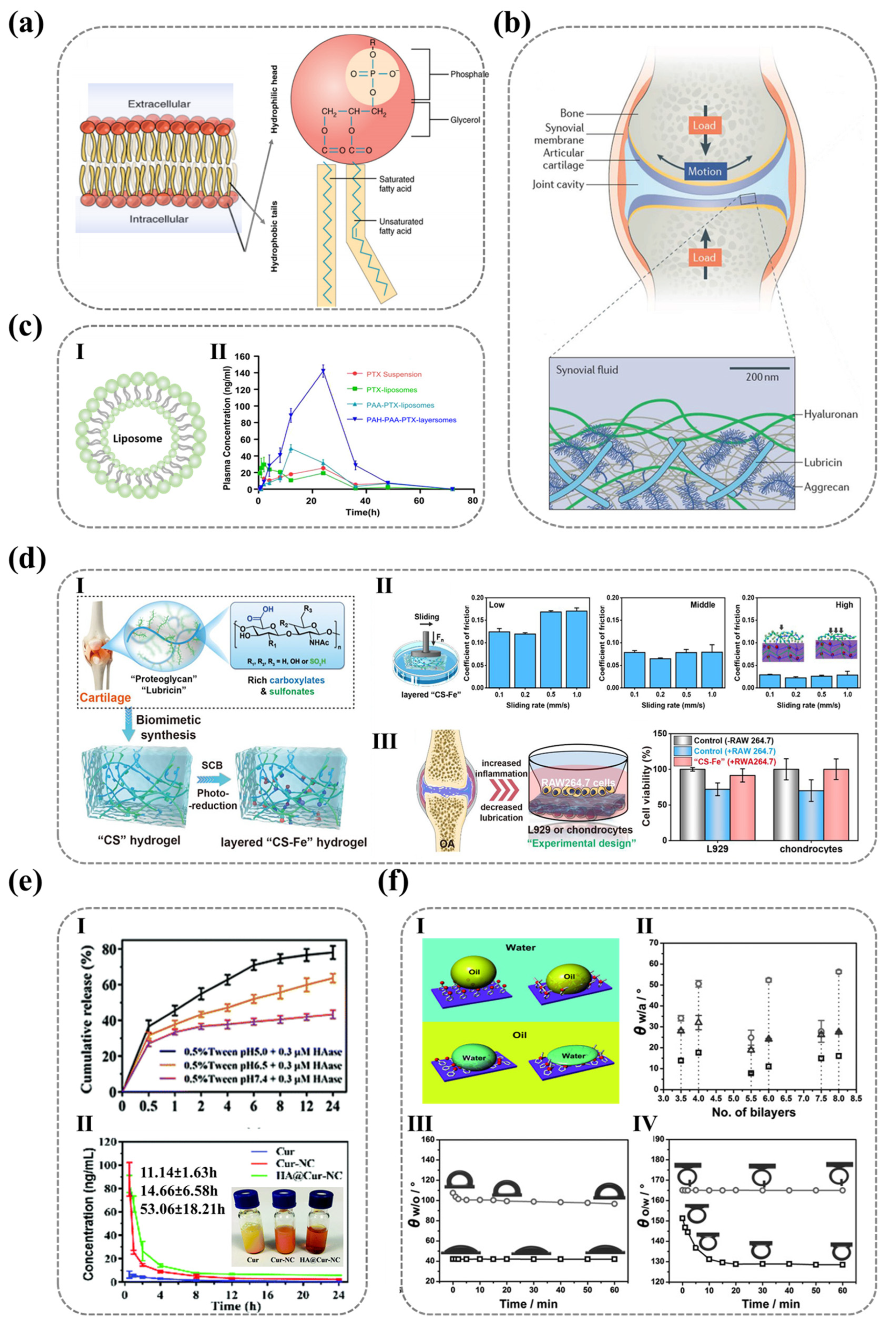
2. Design Approaches for Hydrophilic Ionic Polymer Surfaces
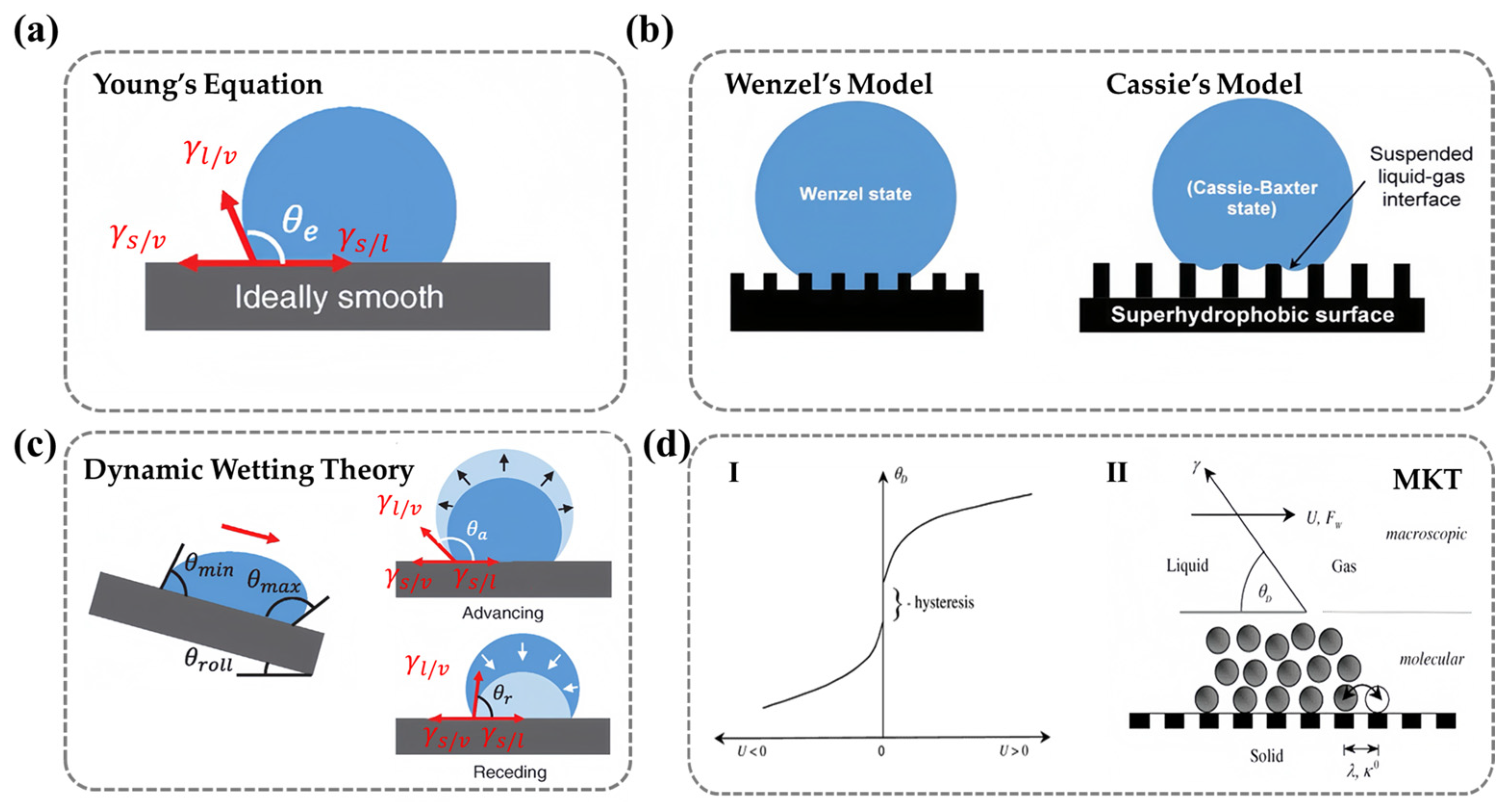
2.1. Construction Strategies for Nano-Smooth Hydrophilic Ionic Polymer Surfaces
2.1.1. Chemical Methods
- A.
- Plasma Treatment
- B.
- Surface-Grafting Treatment
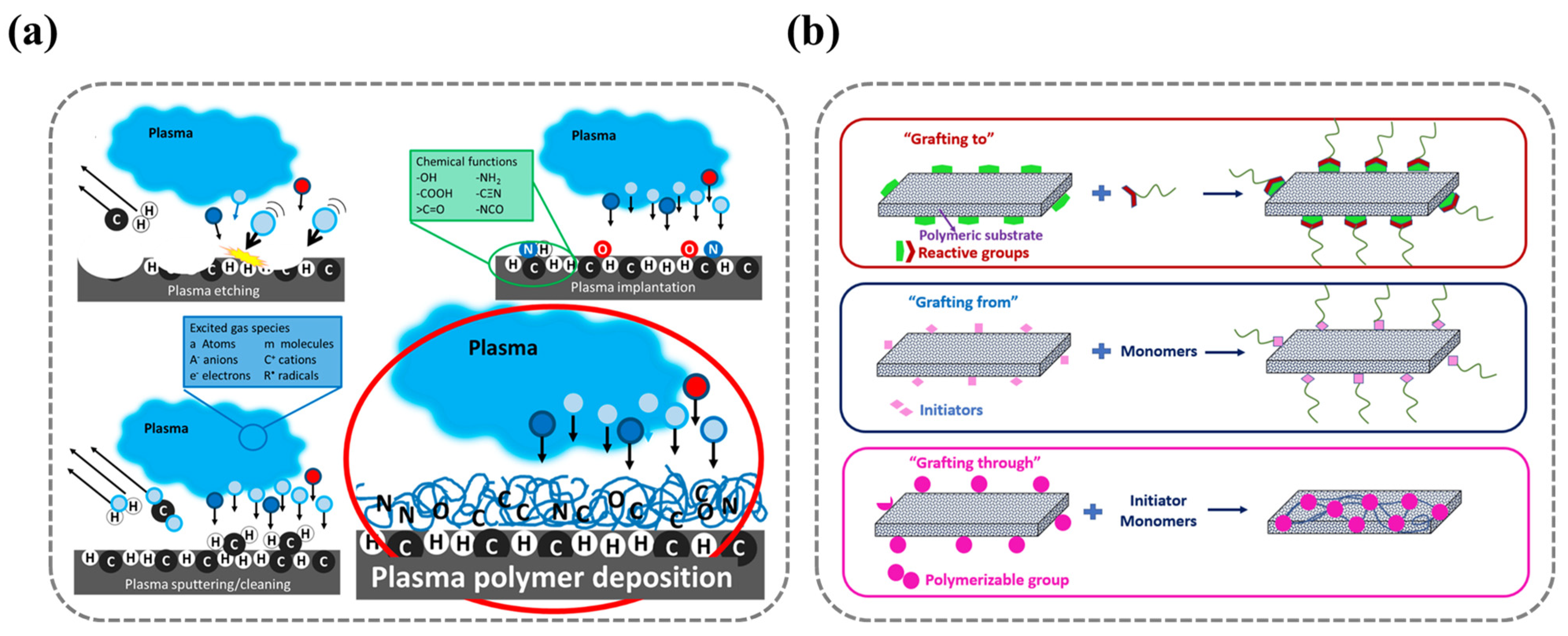
2.1.2. Layer-by-Layer Physical Adsorption Method
- A.
- Immersion Assembly Method: Electrostatic Self-Organization Through
- B.
- Spray Coating Assembly Method: Rapid Atomized Deposition and Uniformity Limitations
- C.
- Spin Coating Assembly Method: Centrifugal Force-Induced Uniform Deposition and Substrate Morphology Limitations
- D.
- Brush-Coating-Assisted Assembly Method: Direct Solution Deposition and Enhanced Molecular Interactions
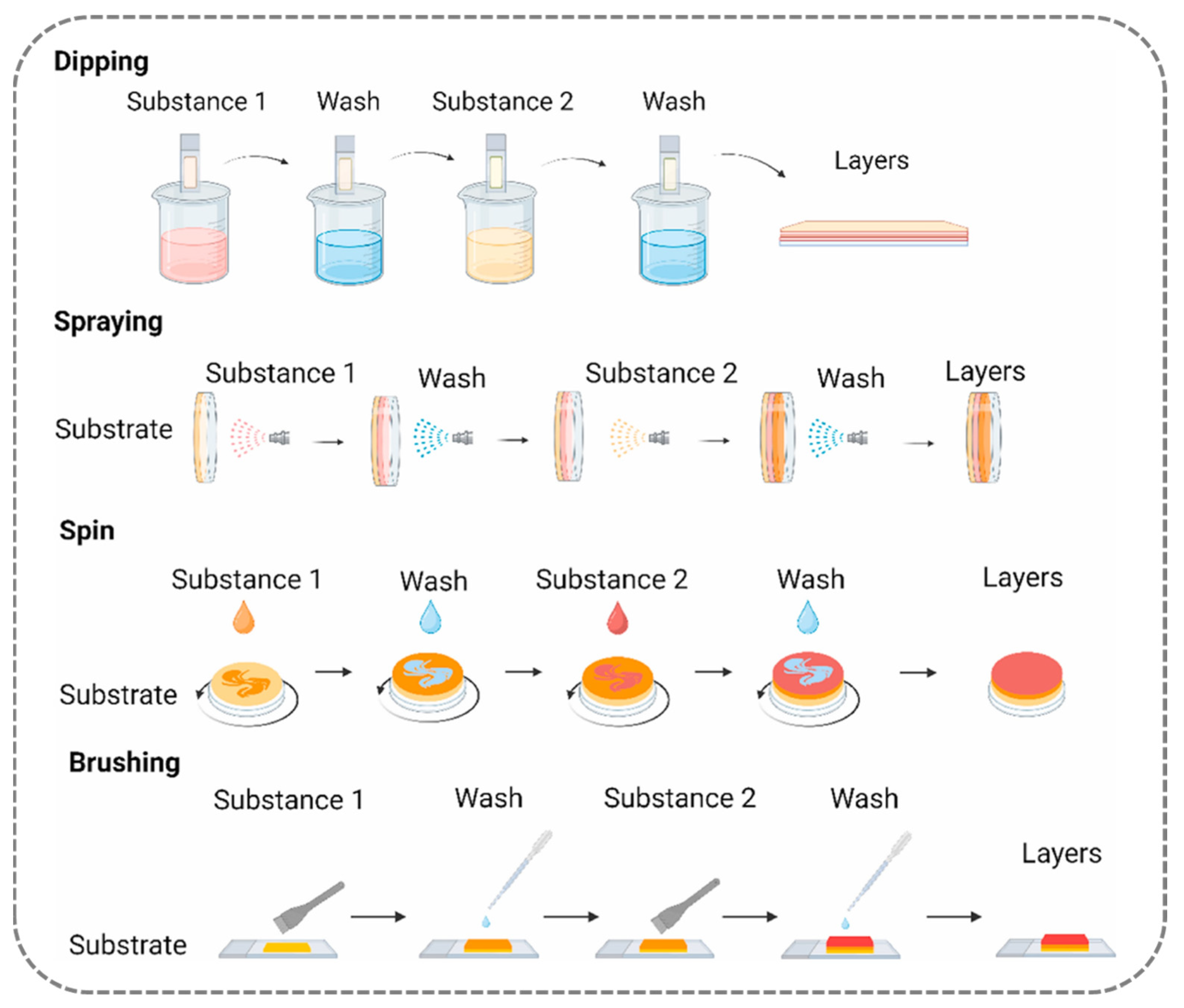
- E.
- Fluidic Assembly Method: Microchannel-Based Dynamic Adsorption and Real-Time Monitoring

| Type | Method | Technology | Principle | Scope of Application | Advantage | Disadvantage | Example | |
|---|---|---|---|---|---|---|---|---|
| Chemical Method | Plasma | Sputtering | React with high-energy reactive substances such as ions, electrons, and free radicals | Metals, polymers, ceramics and composites. | Modify and clean surfaces | Simple and fast High efficiency Shape of substrate is Unlimited | Modified surfaces are unstable sometimes. Require specialized equipment/process control Limited to the surface of the material Damaging material potentially | [41,43,92,93,94,95,96] |
| Etching | Increase surface roughness and patterning | |||||||
| Implantation | Implanting new functional groups | |||||||
| Deposition | Formation of thin organic coatings | |||||||
| Grafting | Grafting onto | Chemically bonding active-end polymer chains to substrates with active groups | Metal, glass, plastic and silicon | Suitable for pre-synthesized polymers | Low graft density Poor structural order | [46,47,52,97] | ||
| Grafting from | Polymer growth initiated by substrate-bound initiator | Enables high-density polymer brushes. | Complex process Risk of monomer self-polymerization | [48,52,97] | ||||
| Grafting Through | Surface-initiated polymerization | Harsh reaction conditions Require post-processing | [50,52,97] | |||||
| Layer-by-Layer Assembly | Immersion | Alternating deposition via non-covalent interactions (electrostatic/van der Waals) | Most materials (metals, glass, plastics, nanoparticles) | Any shape of substrate | Simple process Compatible with automated procedures | Time-consuming High material consumption Cross-contamination risks | [59,60,61,62,63] | |
| Spray | Sequential spraying of oppositely charged polyelectrolytes | Large base substrates | Distinct layered film structure | Non-uniform film thickness Redundant pattern formation | [64,65,66,67,68,69,70,71,72,98] | |||
| Physical Method | Spin | Centrifugal and viscous forces spread the solution across the surface Electrostatic forces arrange polymer chains | Small flat substrates | Fast production speed Compatible with commercial Multilayer structures | Challenging for non-flat substrates non-uniform film thickness | [55,73,74,75,76,77,78,99] | ||
| Brush | Non-covalent interaction between solution and surface or solution | Medium substrates | Precise thickness control Less raw materials required | Poor uniformity/repeatability | [79,80,81] | |||
| Fluidic | Flow-driven alternating adsorption in microchannels | Complex geometries (e.g., capillary interiors) | Spatial adaptability Cost-effective | Limited flow control precision Requires microfluidic expertise Professional equipment | [83,84,85,86,87,88,89,90] | |||
2.2. Molecular-Level Design of Surface Hydrophilicity (Influencing Factors): The Wettability of Solid Surfaces and Its Molecular Correlations
2.2.1. Types of Ionic Polar Functional Groups
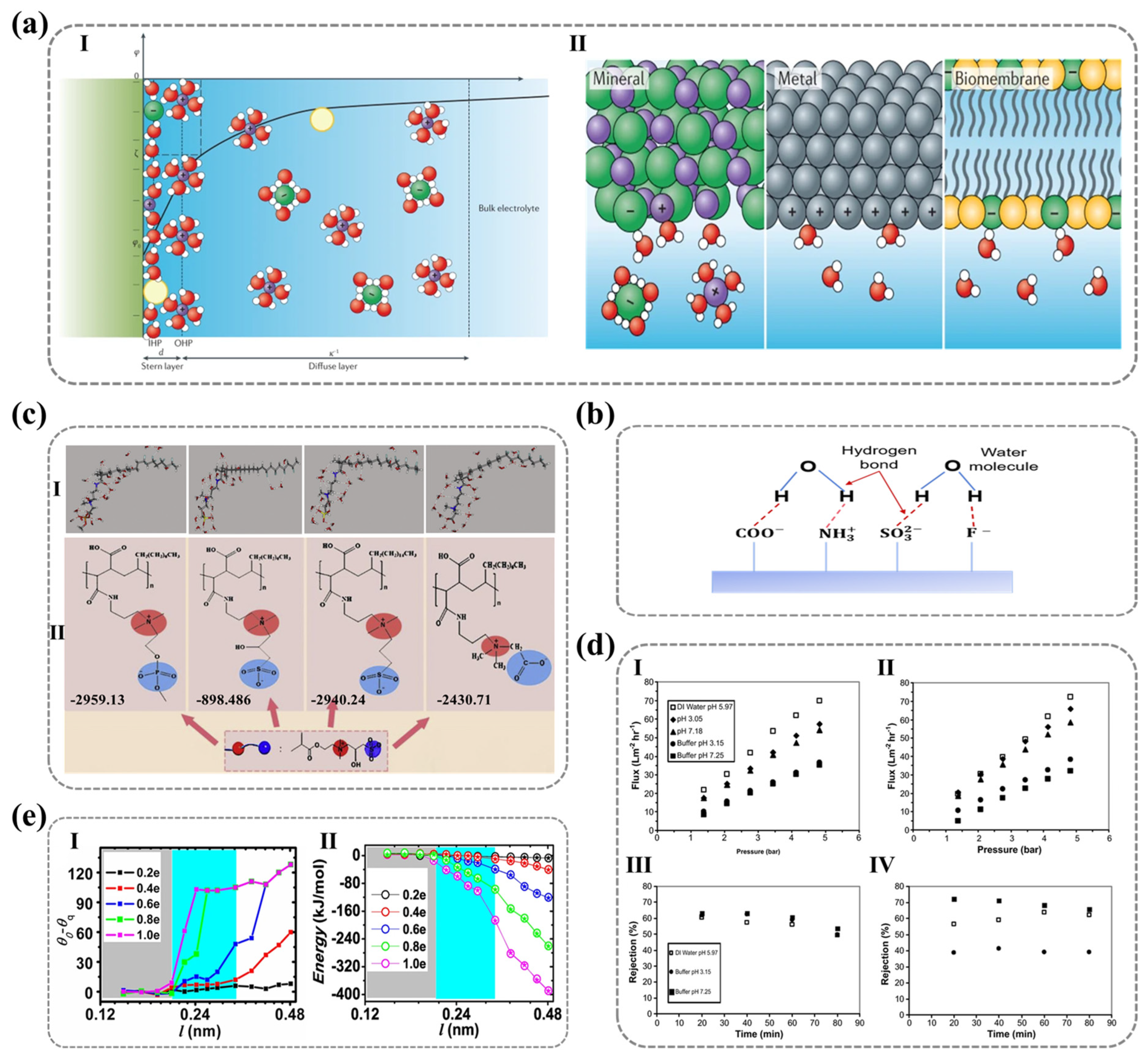
2.2.2. The Molecular Arrangement Pattern on Surfaces (Surface Reconstruction)
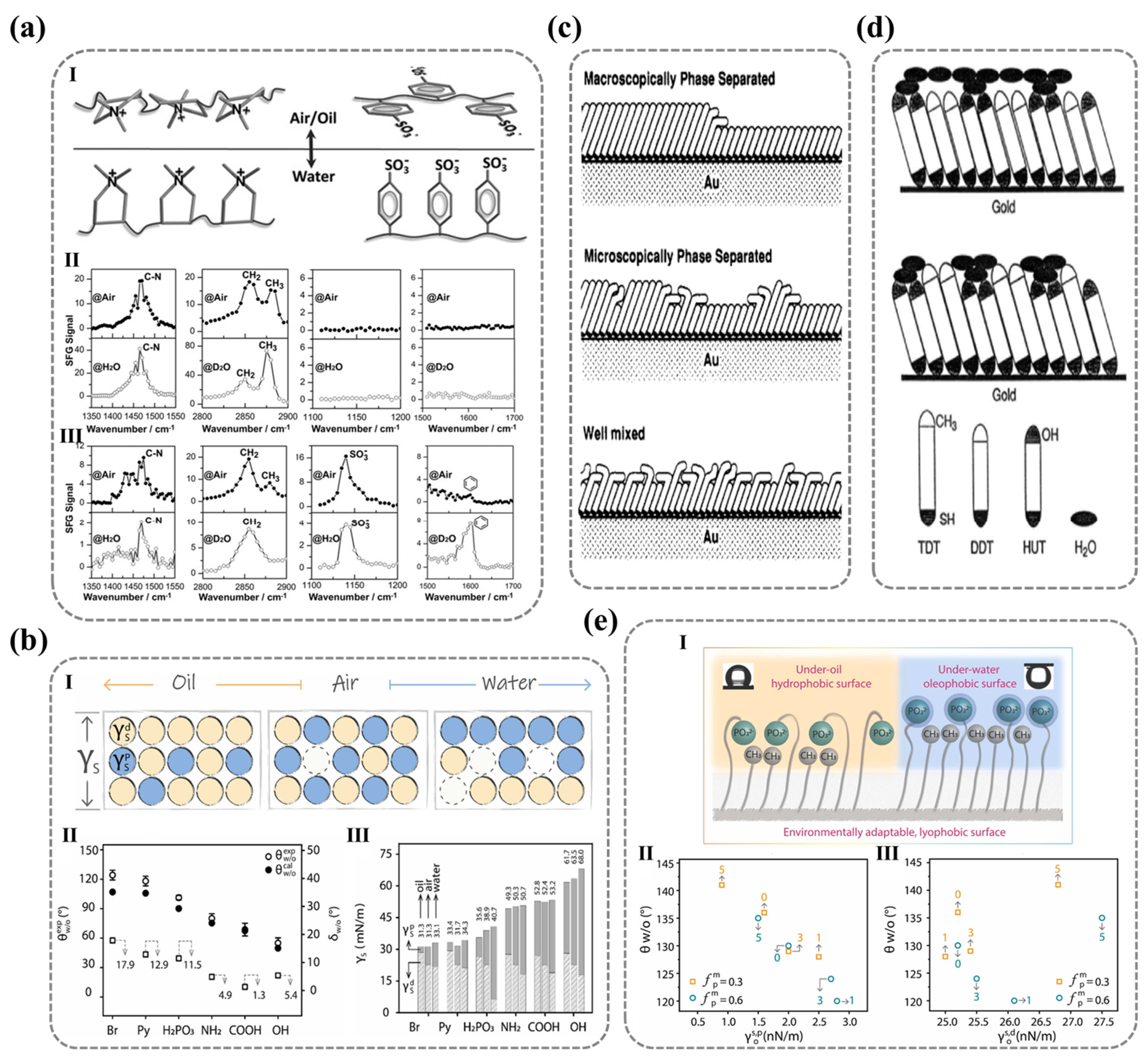
2.2.3. Counter-Ion Effects
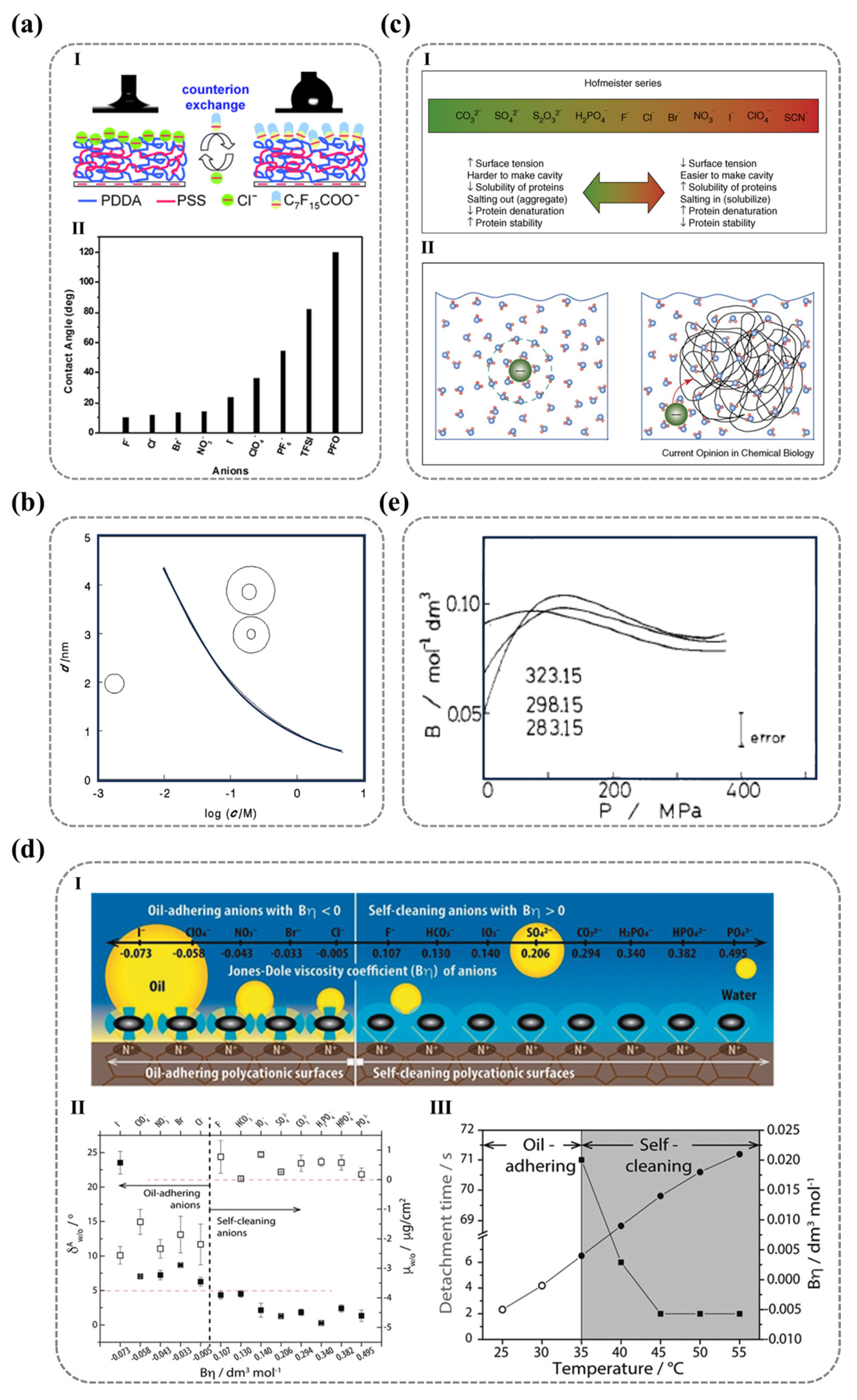
3. Molecular Design-Guided Applications for Hydrophilic Surfaces
3.1. Tunable Hydration Layers for High-Flux Oil–Water Separation ()
3.2. Hydrophilic Anti-Fogging () and Cryo-Tolerant Anti-Icing Interfaces ()

3.3. Hydration-Barrier Strategies Against Paraffin Fouling in Petroleum Systems (Anti-Waxing ())
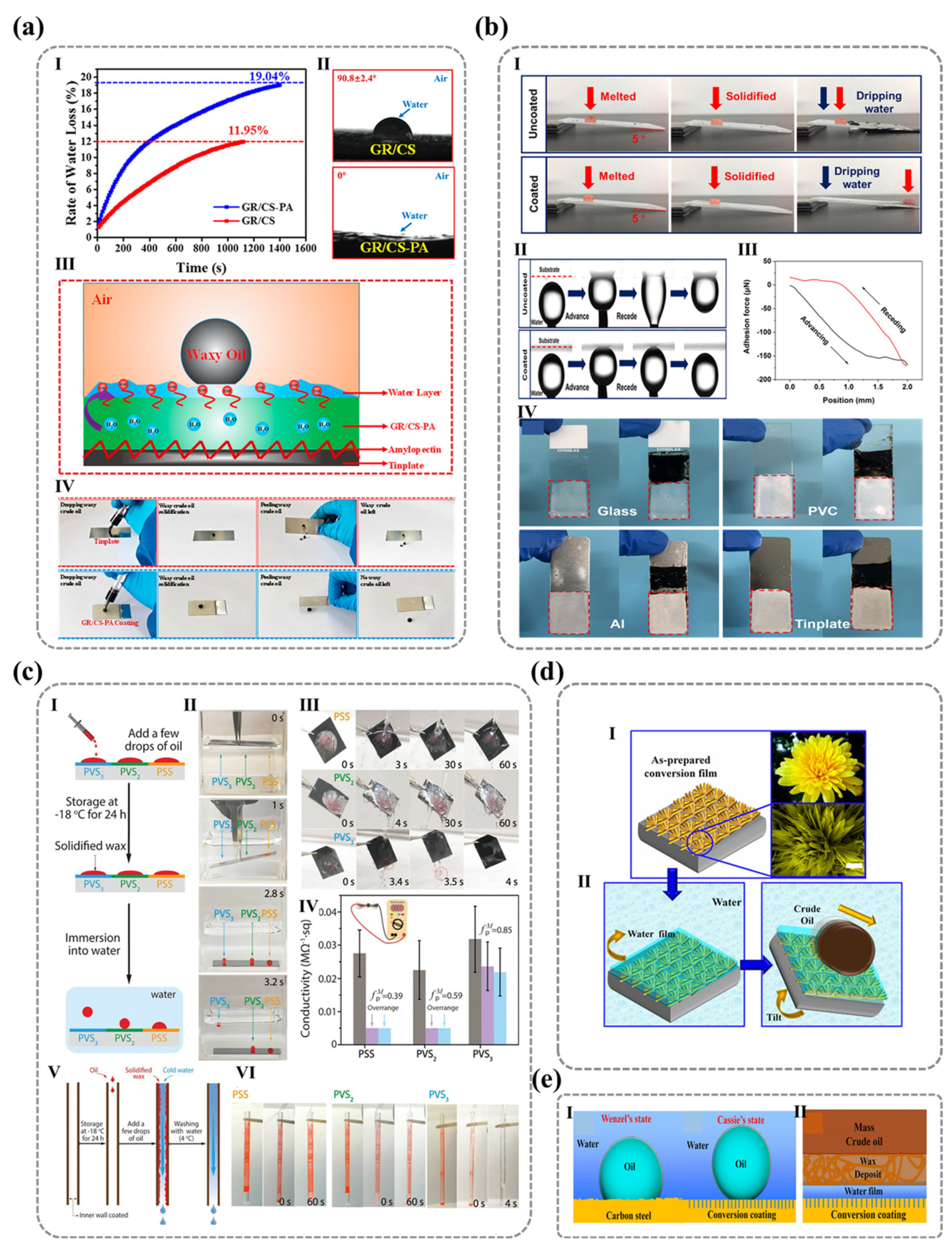
4. Conclusions and Outlook
4.1. Conclusions
4.2. Outlook
- A.
- Surface Reconstruction Induced by Adjacent Non-Polar Groups:
- B.
- Molecular-Scale Roughness of Layer-by-Layer (LBL) Self-Assembled Multilayers:
- C.
- Quantitative Characterization of Counterion Hydration Capacity:
- D.
- Enhancing Surface Hydration and Mitigating Hydrophobic Defect Exposure:
- E.
- Quantitative Self-Cleaning Applications in Air and Underwater:
- F.
- Challenges in Hydrophilic Material Stability and Environmental Responsiveness:
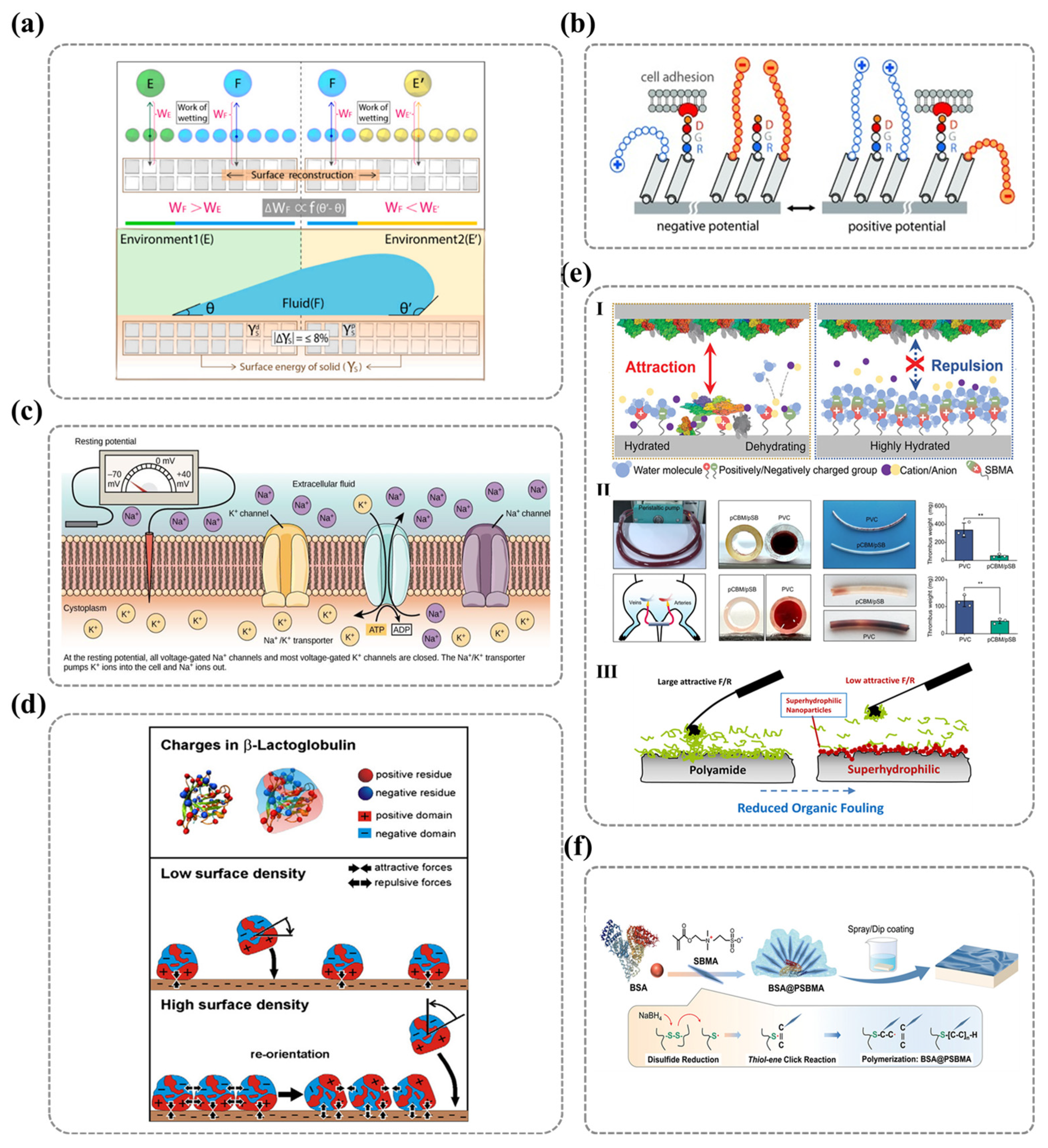
Author Contributions
Funding
Conflicts of Interest
References
- Srivastava, A.; Malik, S.; Karmakar, S.; Debnath, A. Dynamic coupling of a hydration layer to a fluid phospholipid membrane: Intermittency and multiple time-scale relaxations. Phys. Chem. Chem. Phys. 2020, 22, 21158–21168. [Google Scholar] [CrossRef] [PubMed]
- McIntosh, T.J. Chapter 2 Structure and Physical Properties of the Lipid Membrane. In Current Topics in Membranes; Deamer, D.W., Kleinzeller, A., Fambrough, D.M., Eds.; Academic Press: Cambridge, MA, USA, 1999; Volume 48, pp. 23–47. [Google Scholar]
- McLaughlin, S. Salicylates and Phospholipid Bilayer Membranes. Nature 1973, 243, 234–236. [Google Scholar] [CrossRef] [PubMed]
- Xie, A.F.; Granick, S. Phospholipid membranes as substrates for polymer adsorption. Nat. Mater. 2002, 1, 129–133. [Google Scholar] [CrossRef]
- Bordi, F.; Cametti, C.; Naglieri, A. Ionic Transport in Lipid Bilayer Membranes. Biophys. J. 1998, 74, 1358–1370. [Google Scholar] [CrossRef]
- Niu, H.; Maruoka, M.; Noguchi, Y.; Kosako, H.; Suzuki, J. Phospholipid scrambling induced by an ion channel/metabolite transporter complex. Nat. Commun. 2024, 15, 7566. [Google Scholar] [CrossRef]
- Ohki, S. Membrane Potential of Phospholipid Bilayer and Biological Membranes. In Progress in Surface and Membrane Science; Cadenhead, D.A., Danielli, J.F., Eds.; Elsevier: Amsterdam, The Netherlands, 1976; Volume 10, pp. 117–252. [Google Scholar]
- Ohki, S. Membrane potential, surface potential and ionic permeability. Phys. Lett. A 1979, 75, 149–152. [Google Scholar] [CrossRef]
- McLaughlin, S.G.A.; Szabo, G.; Eisenman, G. Divalent Ions and the Surface Potential of Charged Phospholipid Membranes. J. Gen. Physiol. 1971, 58, 667–687. [Google Scholar] [CrossRef]
- Swann, D.A.; Radin, E.L.; Nazimiec, M.; Weisser, P.A.; Curran, N.; Lewinnek, G. Role of hyaluronic acid in joint lubrication. Ann. Rheum. Dis. 1974, 33, 318–326. [Google Scholar] [CrossRef]
- Migliore, A.; Procopio, S. Effectiveness and utility of hyaluronic acid in osteoarthritis. Clin. Cases Min. Bone Metab. 2015, 12, 31–33. [Google Scholar] [CrossRef]
- Hills, B.A.; Butler, B.D. Surfactants identified in synovial fluid and their ability to act as boundary lubricants. Ann. Rheum. Dis. 1984, 43, 641–648. [Google Scholar] [CrossRef]
- Ma, S.; Liu, L.; Zhao, W.; Li, R.; Zhao, X.; Zhang, Y.; Yu, B.; Liu, Y.; Zhou, F. Earthworm inspired lubricant self-pumping hydrogel with sustained lubricity at high loading. Nat. Commun. 2025, 16, 398. [Google Scholar] [CrossRef]
- Cao, Y.; Klein, J. Lipids and lipid mixtures in boundary layers: From hydration lubrication to osteoarthritis. Curr. Opin. Colloid Interface Sci. 2022, 58, 101559. [Google Scholar] [CrossRef]
- Jahn, S.; Seror, J.; Klein, J. Lubrication of Articular Cartilage. Annu. Rev. Biomed. Eng. 2016, 18, 235–258. [Google Scholar] [CrossRef] [PubMed]
- Jain, S.; Kumar, D.; Swarnakar, N.K.; Thanki, K. Polyelectrolyte stabilized multilayered liposomes for oral delivery of paclitaxel. Biomaterials 2012, 33, 6758–6768. [Google Scholar] [CrossRef] [PubMed]
- Yu, P.; Li, Y.; Sun, H.; Ke, X.; Xing, J.; Zhao, Y.; Xu, X.; Qin, M.; Xie, J.; Li, J. Cartilage-Inspired Hydrogel with Mechanical Adaptability, Controllable Lubrication, and Inflammation Regulation Abilities. ACS Appl. Mater. Interfaces 2022, 14, 27360–27370. [Google Scholar] [CrossRef] [PubMed]
- Ji, P.; Wang, L.; Chen, Y.; Wang, S.; Wu, Z.; Qi, X. Hyaluronic acid hydrophilic surface rehabilitating curcumin nanocrystals for targeted breast cancer treatment with prolonged biodistribution. Biomater. Sci. 2020, 8, 462–472. [Google Scholar] [CrossRef]
- Liu, X.; Leng, C.; Yu, L.; He, K.; Brown, L.J.; Chen, Z.; Cho, J.; Wang, D. Ion-Specific Oil Repellency of Polyelectrolyte Multilayers in Water: Molecular Insights into the Hydrophilicity of Charged Surfaces. Angew. Chem. Int. Ed. 2015, 54, 4851–4856. [Google Scholar] [CrossRef]
- Chen, T.; Wei, X.; Chen, Z.; Morin, D.; Alvarez, S.V.; Yoon, Y.; Huang, Y. Designing energy-efficient separation membranes: Knowledge from nature for a sustainable future. Adv. Membr. 2022, 2, 100031. [Google Scholar] [CrossRef]
- Lin, W.; Klein, J. Recent Progress in Cartilage Lubrication. Adv. Mater. 2021, 33, 2005513. [Google Scholar] [CrossRef]
- Young, T. III. An essay on the cohesion of fluids. Philos. Trans. R. Soc. Lond. 1805, 95, 65–87. [Google Scholar] [CrossRef]
- Wenzel, R.N. Resistance of Solid Surfaces to Wetting by Water. Ind. Eng. Chem. 1936, 28, 988–994. [Google Scholar] [CrossRef]
- Wenzel, R.N. Surface Roughness and Contact Angle. J. Phys. Colloid Chem. 1949, 53, 1466–1467. [Google Scholar] [CrossRef]
- Cassie, A.B.D.; Baxter, S. Wettability of porous surfaces. Trans. Faraday Soc. 1944, 40, 546–551. [Google Scholar] [CrossRef]
- Sun, T.; Wang, G.; Feng, L.; Liu, B.; Ma, Y.; Lei, J.; Zhu, D. Reversible Switching between Superhydrophilicity and Superhydrophobicity. Angew. Chem. Int. Ed. 2004, 43, 357–360. [Google Scholar] [CrossRef] [PubMed]
- Bormashenko, E. Wetting of Flat and Rough Curved Surfaces. J. Phys. Chem. C 2009, 113, 17275–17277. [Google Scholar] [CrossRef]
- Widom, B. Capillarity and Wetting Phenomena: Drops, Bubbles, Pearls, Waves. Phys. Today 2004, 57, 66–67. [Google Scholar] [CrossRef]
- Ruiz-Cabello, F.J.M.; Rodríguez-Valverde, M.A.; Cabrerizo-Vílchez, M.A. Equilibrium contact angle or the most-stable contact angle? Adv. Colloid Interface Sci. 2014, 206, 320–327. [Google Scholar] [CrossRef]
- Extrand, C.W.; Kumagai, Y. An Experimental Study of Contact Angle Hysteresis. J. Colloid Interface Sci. 1997, 191, 378–383. [Google Scholar] [CrossRef]
- Chen, Y.L.; Helm, C.A.; Israelachvili, J.N. Molecular mechanisms associated with adhesion and contact angle hysteresis of monolayer surfaces. J. Phys. Chem. 1991, 95, 10736–10747. [Google Scholar] [CrossRef]
- Grundke, K.; Pöschel, K.; Synytska, A.; Frenzel, R.; Drechsler, A.; Nitschke, M.; Cordeiro, A.L.; Uhlmann, P.; Welzel, P.B. Experimental studies of contact angle hysteresis phenomena on polymer surfaces—Toward the understanding and control of wettability for different applications. Adv. Colloid Interface Sci. 2015, 222, 350–376. [Google Scholar] [CrossRef]
- Blake, T.D. The physics of moving wetting lines. J. Colloid Interface Sci. 2006, 299, 1–13. [Google Scholar] [CrossRef]
- Bertrand, E.; Blake, T.D.; De Coninck, J. Dynamics of dewetting. Colloids Surf. A Physicochem. Eng. Asp. 2010, 369, 141–147. [Google Scholar] [CrossRef]
- Ma, Z.; Cheng, C.; Cheng, Q.; Wang, R.; Guo, Z.; Wang, D. Molecular-scale topographic design of multicomponent self-assembled monolayers for environmentally adaptable, lyophobic coating. Colloids Surf. A Physicochem. Eng. Asp. 2024, 694, 134108. [Google Scholar] [CrossRef]
- Jiang, Y.; Choi, C.-H. Droplet Retention on Superhydrophobic Surfaces: A Critical Review. Adv. Mater. Interfaces 2021, 8, 2001205. [Google Scholar] [CrossRef]
- Chu, P.K.; Chen, J.Y.; Wang, L.P.; Huang, N. Plasma-surface modification of biomaterials. Mater. Sci. Eng. R Rep. 2002, 36, 143–206. [Google Scholar] [CrossRef]
- Lai, J.; Sunderland, B.; Xue, J.; Yan, S.; Zhao, W.; Folkard, M.; Michael, B.D.; Wang, Y. Study on hydrophilicity of polymer surfaces improved by plasma treatment. Appl. Surf. Sci. 2006, 252, 3375–3379. [Google Scholar] [CrossRef]
- Junkar, I.; Vesel, A.; Cvelbar, U.; Mozetič, M.; Strnad, S. Influence of oxygen and nitrogen plasma treatment on polyethylene terephthalate (PET) polymers. Vacuum 2009, 84, 83–85. [Google Scholar] [CrossRef]
- Vesel, A.; Junkar, I.; Cvelbar, U.; Kovac, J.; Mozetic, M. Surface modification of polyester by oxygen- and nitrogen-plasma treatment. Surf. Interface Anal. 2008, 40, 1444–1453. [Google Scholar] [CrossRef]
- Zhu, X.; Li, F.; Guan, X.; Xu, J.; Cui, X.; Huang, J.; Liu, F.; Fang, Z. Uniform-saturation modification for hydrophilicity improvement of large-scale PET by plasma-electrified treatment. Eur. Polym. J. 2022, 181, 111656. [Google Scholar] [CrossRef]
- Guimond, S.; Wertheimer, M.R. Surface degradation and hydrophobic recovery of polyolefins treated by air corona and nitrogen atmospheric pressure glow discharge. J. Appl. Polym. Sci. 2004, 94, 1291–1303. [Google Scholar] [CrossRef]
- Sharma, R.; Holcomb, E.; Trigwell, S.; Mazumder, M. Stability of atmospheric-pressure plasma induced changes on polycarbonate surfaces. J. Electrost. 2007, 65, 269–273. [Google Scholar] [CrossRef]
- Guex, A.G.; Kocher, F.M.; Fortunato, G.; Körner, E.; Hegemann, D.; Carrel, T.P.; Tevaearai, H.T.; Giraud, M.N. Fine-tuning of substrate architecture and surface chemistry promotes muscle tissue development. Acta Biomater. 2012, 8, 1481–1489. [Google Scholar] [CrossRef]
- Hegemann, D.; Lorusso, E.; Butron-Garcia, M.-I.; Blanchard, N.E.; Rupper, P.; Favia, P.; Heuberger, M.; Vandenbossche, M. Suppression of Hydrophobic Recovery by Plasma Polymer Films with Vertical Chemical Gradients. Langmuir 2016, 32, 651–654. [Google Scholar] [CrossRef] [PubMed]
- Bhattacharya, A.; Misra, B.N. Grafting: A versatile means to modify polymers: Techniques, factors and applications. Prog. Polym. Sci. 2004, 29, 767–814. [Google Scholar] [CrossRef]
- Alcantar, N.A.; Aydil, E.S.; Israelachvili, J.N. Polyethylene glycol–coated biocompatible surfaces. J. Biomed. Mater. Res. 2000, 51, 343–351. [Google Scholar] [CrossRef] [PubMed]
- Zhang, Z.; Chen, S.; Chang, Y.; Jiang, S. Surface Grafted Sulfobetaine Polymers via Atom Transfer Radical Polymerization as Superlow Fouling Coatings. J. Phys. Chem. B 2006, 110, 10799–10804. [Google Scholar] [CrossRef]
- Henze, M.; Mädge, D.; Prucker, O.; Rühe, J. “Grafting Through”: Mechanistic Aspects of Radical Polymerization Reactions with Surface-Attached Monomers. Macromolecules 2014, 47, 2929–2937. [Google Scholar] [CrossRef]
- Kobayashi, M.; Terayama, Y.; Yamaguchi, H.; Terada, M.; Murakami, D.; Ishihara, K.; Takahara, A. Wettability and Antifouling Behavior on the Surfaces of Superhydrophilic Polymer Brushes. Langmuir 2012, 28, 7212–7222. [Google Scholar] [CrossRef]
- Macgregor, M.; Vasilev, K. Perspective on Plasma Polymers for Applied Biomaterials Nanoengineering and the Recent Rise of Oxazolines. Materials 2019, 12, 191. [Google Scholar] [CrossRef]
- Suresh, D.; Goh, P.S.; Ismail, A.F.; Hilal, N. Surface Design of Liquid Separation Membrane through Graft Polymerization: A State of the Art Review. Membranes 2021, 11, 832. [Google Scholar] [CrossRef]
- Iler, R.K. Multilayers of colloidal particles. J. Colloid Interface Sci. 1966, 21, 569–594. [Google Scholar] [CrossRef]
- Zasadzinski, J.A.; Viswanathan, R.; Madsen, L.; Garnaes, J.; Schwartz, D.K. Langmuir-Blodgett films. Science 1994, 263, 1726–1733. [Google Scholar] [CrossRef] [PubMed]
- Richardson, J.J.; Björnmalm, M.; Caruso, F. Technology-driven layer-by-layer assembly of nanofilms. Science 2015, 348, aaa2491. [Google Scholar] [CrossRef]
- Caruso, F.; Caruso, R.A.; Möhwald, H. Nanoengineering of Inorganic and Hybrid Hollow Spheres by Colloidal Templating. Science 1998, 282, 1111–1114. [Google Scholar] [CrossRef] [PubMed]
- Zhang, X.; Chen, H.; Zhang, H. Layer-by-layer assembly: From conventional to unconventional methods. Chem. Commun. 2007, 14, 1395–1405. [Google Scholar] [CrossRef]
- Decher, G. Layer-by-Layer Assembly (Putting Molecules to Work). In Multilayer Thin Films; IntechOpen: London, UK, 2012; pp. 1–21. [Google Scholar]
- Decher, G. Fuzzy Nanoassemblies: Toward Layered Polymeric Multicomposites. Science 1997, 277, 1232–1237. [Google Scholar] [CrossRef]
- Yang, H.-C.; Liao, K.-J.; Huang, H.; Wu, Q.-Y.; Wan, L.-S.; Xu, Z.-K. Mussel-inspired modification of a polymer membrane for ultra-high water permeability and oil-in-water emulsion separation. J. Mater. Chem. A 2014, 2, 10225–10230. [Google Scholar] [CrossRef]
- Lee, D.; Rubner, M.F.; Cohen, R.E. All-Nanoparticle Thin-Film Coatings. Nano Lett. 2006, 6, 2305–2312. [Google Scholar] [CrossRef]
- Dubas, S.T.; Schlenoff, J.B. Factors Controlling the Growth of Polyelectrolyte Multilayers. Macromolecules 1999, 32, 8153–8160. [Google Scholar] [CrossRef]
- Shim, B.S.; Podsiadlo, P.; Lilly, D.G.; Agarwal, A.; Lee, J.; Tang, Z.; Ho, S.; Ingle, P.; Paterson, D.; Lu, W.; et al. Nanostructured Thin Films Made by Dewetting Method of Layer-By-Layer Assembly. Nano Lett. 2007, 7, 3266–3273. [Google Scholar] [CrossRef]
- Criado-Gonzalez, M.; Fernandez-Gutierrez, M.; San Roman, J.; Mijangos, C.; Hernández, R. Local and controlled release of tamoxifen from multi (layer-by-layer) alginate/chitosan complex systems. Carbohydr. Polym. 2019, 206, 428–434. [Google Scholar] [CrossRef] [PubMed]
- Aoki, P.H.B.; Volpati, D.; Cabrera, F.C.; Trombini, V.L.; Riul, A.; Constantino, C.J.L. Spray layer-by-layer films based on phospholipid vesicles aiming sensing application via e-tongue system. Mater. Sci. Eng. C 2012, 32, 862–871. [Google Scholar] [CrossRef]
- Criado, M.; Rey, J.M.; Mijangos, C.; Hernández, R. Double-membrane thermoresponsive hydrogels from gelatin and chondroitin sulphate with enhanced mechanical properties. RSC Adv. 2016, 6, 105821–105826. [Google Scholar] [CrossRef]
- Schlenoff, J.B.; Dubas, S.T.; Farhat, T. Sprayed Polyelectrolyte Multilayers. Langmuir 2000, 16, 9968–9969. [Google Scholar] [CrossRef]
- Aoki, P.H.B.; Alessio, P.; Volpati, D.; Paulovich, F.V.; Riul, A.; Oliveira, O.N.; Constantino, C.J.L. On the distinct molecular architectures of dipping- and spray-LbL films containing lipid vesicles. Mater. Sci. Eng. C 2014, 41, 363–371. [Google Scholar] [CrossRef]
- Criado, M.; Rebollar, E.; Nogales, A.; Ezquerra, T.A.; Boulmedais, F.; Mijangos, C.; Hernández, R. Quantitative Nanomechanical Properties of Multilayer Films Made of Polysaccharides through Spray Assisted Layer-by-Layer Assembly. Biomacromolecules 2017, 18, 169–177. [Google Scholar] [CrossRef]
- Schaaf, P.; Voegel, J.-C.; Jierry, L.; Boulmedais, F. Spray-Assisted Polyelectrolyte Multilayer Buildup: From Step-by-Step to Single-Step Polyelectrolyte Film Constructions. Adv. Mater. 2012, 24, 1001–1016. [Google Scholar] [CrossRef] [PubMed]
- Krogman, K.C.; Cohen, R.E.; Hammond, P.T.; Rubner, M.F.; Wang, B.N. Industrial-scale spray layer-by-layer assembly for production of biomimetic photonic systems. Bioinspir. Biomim. 2013, 8, 045005. [Google Scholar] [CrossRef]
- Krogman, K.C.; Lowery, J.L.; Zacharia, N.S.; Rutledge, G.C.; Hammond, P.T. Spraying asymmetry into functional membranes layer-by-layer. Nat. Mater. 2009, 8, 512–518. [Google Scholar] [CrossRef]
- Song, S.; Jing, L.; Li, S.; Fu, H.; Luan, Y. Superhydrophilic anatase TiO2 film with the micro- and nanometer-scale hierarchical surface structure. Mater. Lett. 2008, 62, 3503–3505. [Google Scholar] [CrossRef]
- Chiarelli, P.A.; Johal, M.S.; Casson, J.L.; Roberts, J.B.; Robinson, J.M.; Wang, H.-L. Controlled Fabrication of Polyelectrolyte Multilayer Thin Films Using Spin-Assembly. Adv. Mater. 2001, 13, 1167–1171. [Google Scholar] [CrossRef]
- Cho, J.; Char, K.; Hong, J.-D.; Lee, K.-B. Fabrication of Highly Ordered Multilayer Films Using a Spin Self-Assembly Method. Adv. Mater. 2001, 13, 1076–1078. [Google Scholar] [CrossRef]
- Zhuk, I.; Jariwala, F.; Attygalle, A.B.; Wu, Y.; Libera, M.R.; Sukhishvili, S.A. Self-Defensive Layer-by-Layer Films with Bacteria-Triggered Antibiotic Release. ACS Nano 2014, 8, 7733–7745. [Google Scholar] [CrossRef]
- Salomäki, M.; Marttila, L.; Kivelä, H.; Tupala, M.; Lukkari, J. Oxidative Spin-Spray-Assembled Coordinative Multilayers as Platforms for Capacitive Films. Langmuir 2020, 36, 6736–6748. [Google Scholar] [CrossRef] [PubMed]
- Stana, J.; Stergar, J.; Gradišnik, L.; Flis, V.; Kargl, R.; Fröhlich, E.; Stana Kleinschek, K.; Mohan, T.; Maver, U. Multilayered Polysaccharide Nanofilms for Controlled Delivery of Pentoxifylline and Possible Treatment of Chronic Venous Ulceration. Biomacromolecules 2017, 18, 2732–2746. [Google Scholar] [CrossRef] [PubMed]
- Park, K.; Choi, D.; Hong, J. Nanostructured Polymer Thin Films Fabricated with Brush-based Layer-by-Layer Self-assembly for Site-selective Construction and Drug release. Sci. Rep. 2018, 8, 3365. [Google Scholar] [CrossRef]
- Iqbal, M.H.; Revana, F.J.R.; Pradel, E.; Gribova, V.; Mamchaoui, K.; Coirault, C.; Meyer, F.; Boulmedais, F. Brush-Induced Orientation of Collagen Fibers in Layer-by-Layer Nanofilms: A Simple Method for the Development of Human Muscle Fibers. ACS Nano 2022, 16, 20034–20043. [Google Scholar] [CrossRef]
- Li, Q.; Zhang, N.; Li, Z.; Gao, Z.; Yan, T.; Qian, Z.; Xu, S.; Wang, J. Brush assisted layer-by-layer assembled lignin/polyelectrolyte membrane. Mater. Lett. 2021, 292, 129650. [Google Scholar] [CrossRef]
- dos Santos, V.L.S.; Araújo, R.C.; Lisboa, E.S.; Lopes, A.M.; de Albuquerque-Júnior, R.L.; Cardoso, J.C.; Blanco-Llamero, C.; Deshpande, T.A.; Anderson, H.O.W.; Priefer, R.; et al. Layer-by-layer assembly: A versatile approach for tailored biomedical films and drug delivery. J. Drug Deliv. Sci. Technol. 2024, 91, 105243. [Google Scholar] [CrossRef]
- Wang, Y.; Liu, Y.; Cheng, Y.; Kim, E.; Rubloff, G.W.; Bentley, W.E.; Payne, G.F. Coupling Electrodeposition with Layer-by-Layer Assembly to Address Proteins within Microfluidic Channels. Adv. Mater. 2011, 23, 5817–5821. [Google Scholar] [CrossRef]
- Raman, N.; Lee, M.-R.; Palecek, S.P.; Lynn, D.M. Polymer multilayers loaded with antifungal β-peptides kill planktonic Candida albicans and reduce formation of fungal biofilms on the surfaces of flexible catheter tubes. J. Control. Release 2014, 191, 54–62. [Google Scholar] [CrossRef]
- Madaboosi, N.; Uhlig, K.; Jäger, M.S.; Möhwald, H.; Duschl, C.; Volodkin, D.V. Microfluidics as A Tool to Understand the Build-Up Mechanism of Exponential-Like Growing Films. Macromol. Rapid Commun. 2012, 33, 1775–1779. [Google Scholar] [CrossRef]
- Barker, S.L.R.; Ross, D.; Tarlov, M.J.; Gaitan, M.; Locascio, L.E. Control of Flow Direction in Microfluidic Devices with Polyelectrolyte Multilayers. Anal. Chem. 2000, 72, 5925–5929. [Google Scholar] [CrossRef] [PubMed]
- Reyes, D.R.; Perruccio, E.M.; Becerra, S.P.; Locascio, L.E.; Gaitan, M. Micropatterning Neuronal Cells on Polyelectrolyte Multilayers. Langmuir 2004, 20, 8805–8811. [Google Scholar] [CrossRef] [PubMed]
- Jang, H.; Kim, S.; Char, K. Multilayer Line Micropatterning Using Convective Self-Assembly in Microfluidic Channels. Langmuir 2003, 19, 3094–3097. [Google Scholar] [CrossRef]
- Picart, C.; Lavalle, P.; Hubert, P.; Cuisinier, F.J.G.; Decher, G.; Schaaf, P.; Voegel, J.C. Buildup Mechanism for Poly(l-lysine)/Hyaluronic Acid Films onto a Solid Surface. Langmuir 2001, 17, 7414–7424. [Google Scholar] [CrossRef]
- Craig, V.S.J.; Plunkett, M. Determination of coupled solvent mass in quartz crystal microbalance measurements using deuterated solvents. J. Colloid Interface Sci. 2003, 262, 126–129. [Google Scholar] [CrossRef]
- Holmlin, R.E.; Chen, X.; Chapman, R.G.; Takayama, S.; Whitesides, G.M. Zwitterionic SAMs that Resist Nonspecific Adsorption of Protein from Aqueous Buffer. Langmuir 2001, 17, 2841–2850. [Google Scholar] [CrossRef]
- Brewis, D.M. (Ed.) Surface Analysis and Pretreatment of Plastics and Metals; Applied Science: London, UK, 1982; Volume 4, p. ii. ISBN 0-35334-992-4. [Google Scholar] [CrossRef]
- Mozetič, M. Plasma-Stimulated Super-Hydrophilic Surface Finish of Polymers. Polymers 2020, 12, 2498. [Google Scholar] [CrossRef]
- Ferguson, G.S.; Chaudhury, M.K.; Biebuyck, H.A.; Whitesides, G.M. Monolayers on disordered substrates: Self-assembly of alkyltrichlorosilanes on surface-modified polyethylene and poly(dimethylsiloxane). Macromolecules 1993, 26, 5870–5875. [Google Scholar] [CrossRef]
- Siow, K.S.; Britcher, L.; Kumar, S.; Griesser, H.J. Plasma Methods for the Generation of Chemically Reactive Surfaces for Biomolecule Immobilization and Cell Colonization-A Review. Plasma Process. Polym. 2006, 3, 392–418. [Google Scholar] [CrossRef]
- O’Hare, L.-A.; Leadley, S.; Parbhoo, B. Surface physicochemistry of corona-discharge-treated polypropylene film. Surf. Interface Anal. 2002, 33, 335–342. [Google Scholar] [CrossRef]
- Lee, X.J.; Show, P.L.; Katsuda, T.; Chen, W.-H.; Chang, J.-S. Surface grafting techniques on the improvement of membrane bioreactor: State-of-the-art advances. Bioresour. Technol. 2018, 269, 489–502. [Google Scholar] [CrossRef]
- Donath, E.; Sukhorukov, G.B.; Caruso, F.; Davis, S.A.; Möhwald, H. Novel Hollow Polymer Shells by Colloid-Templated Assembly of Polyelectrolytes. Angew. Chem. Int. Ed. 1998, 37, 2201–2205. [Google Scholar] [CrossRef]
- Patel, P.A.; Dobrynin, A.V.; Mather, P.T. Combined Effect of Spin Speed and Ionic Strength on Polyelectrolyte Spin Assembly. Langmuir 2007, 23, 12589–12597. [Google Scholar] [CrossRef]
- Cheng, G.; Liao, M.; Zhao, D.; Zhou, J. Molecular Understanding on the Underwater Oleophobicity of Self-Assembled Monolayers: Zwitterionic versus Nonionic. Langmuir 2017, 33, 1732–1741. [Google Scholar] [CrossRef] [PubMed]
- Sposito, G. Gouy-Chapman Theory. In Encyclopedia of Geochemistry: A Comprehensive Reference Source on the Chemistry of the Earth; White, W.M., Ed.; Springer International Publishing: Cham, Switzerland, 2018; pp. 623–628. [Google Scholar]
- Adair, J.H.; Suvaci, E.; Sindel, J. Surface and Colloid Chemistry. In Encyclopedia of Materials: Science and Technology; Buschow, K.H.J., Cahn, R.W., Flemings, M.C., Ilschner, B., Kramer, E.J., Mahajan, S., Veyssière, P., Eds.; Elsevier: Oxford, UK, 2001; pp. 1–10. [Google Scholar]
- Derjaguin, B.V.; Churaev, N.V.; Muller, V.M. The Derjaguin—Landau—Verwey—Overbeek (DLVO) Theory of Stability of Lyophobic Colloids. In Surface Forces; Derjaguin, B.V., Churaev, N.V., Muller, V.M., Eds.; Springer US: Boston, MA, USA, 1987; pp. 293–310. [Google Scholar]
- Schlenoff, J.B. Zwitteration: Coating Surfaces with Zwitterionic Functionality to Reduce Nonspecific Adsorption. Langmuir 2014, 30, 9625–9636. [Google Scholar] [CrossRef]
- Maghami, M.; Abdelrasoul, A. A comprehensive computational study and simulation of innovative zwitterionic materials for enhanced poly (vinylidene fluoride) membrane hydrophilicity. J. Mol. Graph. Model. 2020, 100, 107656. [Google Scholar] [CrossRef]
- Himstedt, H.H.; Du, H.; Marshall, K.M.; Wickramasinghe, S.R.; Qian, X. pH Responsive Nanofiltration Membranes for Sugar Separations. Ind. Eng. Chem. Res. 2013, 52, 9259–9269. [Google Scholar] [CrossRef]
- Himstedt, H.H.; Marshall, K.M.; Wickramasinghe, S.R. pH-responsive nanofiltration membranes by surface modification. J. Membr. Sci. 2011, 366, 373–381. [Google Scholar] [CrossRef]
- Wang, C.; Zhou, B.; Tu, Y.; Duan, M.; Xiu, P.; Li, J.; Fang, H. Critical Dipole Length for the Wetting Transition Due to Collective Water-dipoles Interactions. Sci. Rep. 2012, 2, 358. [Google Scholar] [CrossRef]
- Gonella, G.; Backus, E.H.G.; Nagata, Y.; Bonthuis, D.J.; Loche, P.; Schlaich, A.; Netz, R.R.; Kühnle, A.; McCrum, I.T.; Koper, M.T.M.; et al. Water at charged interfaces. Nat. Rev. Chem. 2021, 5, 466–485. [Google Scholar] [CrossRef] [PubMed]
- Lee, S.H.; Ruckenstein, E. Surface restructuring of polymers. J. Colloid Interface Sci. 1987, 120, 529–536. [Google Scholar] [CrossRef]
- Ma, Z.; Wang, D. Thermodynamic expression of surface reconstruction impact on surface wettability. Colloids Surf. A Physicochem. Eng. Asp. 2023, 675, 132031. [Google Scholar] [CrossRef]
- Huang, S.; Wang, D. A Simple Nanocellulose Coating for Self-Cleaning upon Water Action: Molecular Design of Stable Surface Hydrophilicity. Angew. Chem. Int. Ed. 2017, 56, 9053–9057. [Google Scholar] [CrossRef]
- Żenkiewicz, M. Methods for the calculation of surface free energy of solids. J. Achiev. Mater. Manuf. Eng. 2007, 24, 137–145. [Google Scholar]
- Fowkes, F.M. Attractive Forces at Interfaces. Ind. Eng. Chem. 1964, 56, 40–52. [Google Scholar] [CrossRef]
- Owens, D.K.; Wendt, R.C. Estimation of the surface free energy of polymers. J. Appl. Polym. Sci. 1969, 13, 1741–1747. [Google Scholar] [CrossRef]
- Laibinis, P.E.; Nuzzo, R.G.; Whitesides, G.M. Structure of monolayers formed by coadsorption of two n-alkanethiols of different chain lengths on gold and its relation to wetting. J. Phys. Chem. 1992, 96, 5097–5105. [Google Scholar] [CrossRef]
- Ulman, A.; Evans, S.D.; Shnidman, Y.; Sharma, R.; Eilers, J.E.; Chang, J.C. Concentration-driven surface transition in the wetting of mixed alkanethiol monolayers on gold. J. Am. Chem. Soc. 1991, 113, 1499–1506. [Google Scholar] [CrossRef]
- Wang, L.; Lin, Y.; Su, Z. Counterion exchange at the surface of polyelectrolyte multilayer film for wettability modulation. Soft Matter 2009, 5, 2072–2078. [Google Scholar] [CrossRef]
- Marcus, Y. Effect of Ions on the Structure of Water: Structure Making and Breaking. Chem. Rev. 2009, 109, 1346–1370. [Google Scholar] [CrossRef] [PubMed]
- Zhang, Y.; Cremer, P.S. Interactions between macromolecules and ions: The Hofmeister series. Curr. Opin. Chem. Biol. 2006, 10, 658–663. [Google Scholar] [CrossRef] [PubMed]
- Ohtaki, H.; Radnai, T. Structure and dynamics of hydrated ions. Chem. Rev. 1993, 93, 1157–1204. [Google Scholar] [CrossRef]
- Gurney, R.W. Ionic Processes in Solution; McGraw-Hill Book Company: New York, NY, USA, 1953. [Google Scholar]
- Cacace, M.G.; Landau, E.M.; Ramsden, J.J. The Hofmeister series: Salt and solvent effects on interfacial phenomena. Q. Rev. Biophys. 1997, 30, 241–277. [Google Scholar] [CrossRef]
- Hofmeister, F. Zur Lehre von der Wirkung der Salze. Arch. Für Exp. Pathol. Und Pharmakol. 1888, 25, 1–30. [Google Scholar] [CrossRef]
- Pegram, L.M.; Record, M.T. Hofmeister Salt Effects on Surface Tension Arise from Partitioning of Anions and Cations between Bulk Water and the Air−Water Interface. J. Phys. Chem. B 2007, 111, 5411–5417. [Google Scholar] [CrossRef]
- Gurau, M.C.; Lim, S.-M.; Castellana, E.T.; Albertorio, F.; Kataoka, S.; Cremer, P.S. On the Mechanism of the Hofmeister Effect. J. Am. Chem. Soc. 2004, 126, 10522–10523. [Google Scholar] [CrossRef]
- von Keussler, V.V. Über Wellenlängenänderung in den HI- und He I-ähnlichen Spektren infolge der elektro-magnetischen Verschiebung des Grundterms. Z. Für Naturforschung A 1949, 4, 158–160. [Google Scholar] [CrossRef]
- Jones, G.; Christian, S.M. The Viscosity of Aqueous Solutions of Electrolytes as a Function of the Concentration. V. Sodium Chloride. J. Am. Chem. Soc. 1937, 59, 484–486. [Google Scholar] [CrossRef]
- Jones, G.; Dole, M. The viscosity of aqueous solutions of strong electrolytes with special reference to barium chloride. J. Am. Chem. Soc. 1929, 51, 2950–2964. [Google Scholar] [CrossRef]
- Jenkins, H.D.B.; Marcus, Y. Viscosity B-Coefficients of Ions in Solution. Chem. Rev. 1995, 95, 2695–2724. [Google Scholar] [CrossRef]
- Van Damme, H.S.; Hogt, A.H.; Feijen, J. Surface mobility and structural transitions of poly(n-alkyl methacrylates) probed by dynamic contact angle measurements. J. Colloid Interface Sci. 1986, 114, 167–172. [Google Scholar] [CrossRef][Green Version]
- Tao, Q.; Huang, S.; Li, X.; Chu, X.-F.; Lu, X.; Wang, D. Counterion-Dictated Self-Cleaning Behavior of Polycation Coating upon Water Action: Macroscopic Dissection of Hydration of Anions. Angew. Chem. Int. Ed. 2020, 59, 14466–14472. [Google Scholar] [CrossRef]
- Nightingale, E.R., Jr. Viscosity of Aqueous Sodium Perchlorate Solutions. J. Phys. Chem. 1959, 63, 742–743. [Google Scholar] [CrossRef]
- Sawamura, S.; Yoshimura, Y.; Kitamura, K.; Taniguchi, Y. Effects of pressure, temperature, and concentration on the viscosity of an aqueous solution of sodium chloride. J. Phys. Chem. 1992, 96, 5526–5529. [Google Scholar] [CrossRef]
- Ramiasa, M.; Ralston, J.; Fetzer, R.; Sedev, R.; Fopp-Spori, D.M.; Morhard, C.; Pacholski, C.; Spatz, J.P. Contact Line Motion on Nanorough Surfaces: A Thermally Activated Process. J. Am. Chem. Soc. 2013, 135, 7159–7171. [Google Scholar] [CrossRef]
- Huang, D.-J.; Leu, T.-S. Fabrication of high wettability gradient on copper substrate. Appl. Surf. Sci. 2013, 280, 25–32. [Google Scholar] [CrossRef]
- Dai, X.; Sun, N.; Nielsen, S.O.; Stogin, B.B.; Wang, J.; Yang, S.; Wong, T.-S. Hydrophilic directional slippery rough surfaces for water harvesting. Sci. Adv. 2018, 4, eaaq0919. [Google Scholar] [CrossRef]
- Wang, R.; Cheng, C.; Wang, H.; Tao, Q.; Wang, D. A Simple Poly(Vinyl Sulfonate) Coating for All-Purpose, Self-Cleaning Applications: Molecular Packing Density–Defined Surface Superhydrophilicity. Adv. Funct. Mater. 2023, 33, 2301085. [Google Scholar] [CrossRef]
- Cannon, W.R.; Pettitt, B.M.; McCammon, J.A. Sulfate Anion in Water: Model Structural, Thermodynamic, and Dynamic Properties. J. Phys. Chem. 1994, 98, 6225–6230. [Google Scholar] [CrossRef]
- Wu, Y.; Fan, Z.; Lu, Y. Bulk and interior packing densities of random close packing of hard spheres. J. Mater. Sci. 2003, 38, 2019–2025. [Google Scholar] [CrossRef]
- Kim, D.-H.; Mauchauffé, R.; Kim, J.; Moon, S.Y. Simultaneous, efficient and continuous oil–water separation via antagonistically functionalized membranes prepared by atmospheric-pressure cold plasma. Sci. Rep. 2021, 11, 3169. [Google Scholar] [CrossRef] [PubMed]
- Shen, S.; Li, H.; Shen, Y.; Bai, R.; Zhang, G. Modification of PVDF membrane by post-modified NH2-MIL-88B(Fe) showing improved permeability and oil/water separation performance. J. Environ. Chem. Eng. 2023, 11, 109621. [Google Scholar] [CrossRef]
- Collini, H.; Li, S.; Jackson, M.D.; Agenet, N.; Rashid, B.; Couves, J. Zeta potential in intact carbonates at reservoir conditions and its impact on oil recovery during controlled salinity waterflooding. Fuel 2020, 266, 116927. [Google Scholar] [CrossRef]
- Collini, H.; Jackson, M.D. Zeta potential of crude oil in aqueous solution. Adv. Colloid Interface Sci. 2023, 320, 102962. [Google Scholar] [CrossRef]
- Shi, C.; Yan, B.; Xie, L.; Zhang, L.; Wang, J.; Takahara, A.; Zeng, H. Long-Range Hydrophilic Attraction between Water and Polyelectrolyte Surfaces in Oil. Angew. Chem. Int. Ed. 2016, 55, 15017–15021. [Google Scholar] [CrossRef]
- Du, B.; Chen, F.; Luo, R.; Li, H.; Zhou, S.; Liu, S.; Hu, J. Superhydrophobic Surfaces with pH-Induced Switchable Wettability for Oil–Water Separation. ACS Omega 2019, 4, 16508–16516. [Google Scholar] [CrossRef]
- Guo, X.-Y.; Zhao, L.; Li, H.-N.; Yang, H.-C.; Wu, J.; Liang, H.-Q.; Zhang, C.; Xu, Z.-K. Janus channel of membranes enables concurrent oil and water recovery from emulsions. Science 2024, 386, 654–659. [Google Scholar] [CrossRef]
- Zeng, X.; Lin, J.; Cai, W.; Lu, Q.; Fu, S.; Li, J.; Yan, X.; Wen, X.; Zhou, C.; Zhang, M. Fabrication of superhydrophilic PVDF membranes by one-step modification with eco-friendly phytic acid and polyethyleneimine complex for oil-in-water emulsions separation. Chemosphere 2021, 264, 128395. [Google Scholar] [CrossRef]
- San-Juan, M.; Martín, Ó.; Mirones, B.J.; De Tiedra, P. Assessment of efficiency of windscreen demisting systems in electrical vehicles by using IR thermography. Appl. Therm. Eng. 2016, 104, 479–485. [Google Scholar] [CrossRef]
- Laforte, J.L.; Allaire, M.A.; Laflamme, J. State-of-the-art on power line de-icing. Atmos. Res. 1998, 46, 143–158. [Google Scholar] [CrossRef]
- Leary, W.M. “We Freeze to Please”: A History of NASA’s Icing Research Tunnel and the Quest for Flight Safety; National Aeronautics and Space Administration: Washington, DC, USA, 2002.
- Lin, S.; Yang, Y.; Ni, J.; Tsurimaki, Y.; Liu, X.; Lu, B.; Tu, Y.; Zhou, J.; Zhao, X.; Chen, G. Stretchable Anti-Fogging Tapes for Diverse Transparent Materials. Adv. Funct. Mater. 2021, 31, 2103551. [Google Scholar] [CrossRef]
- Nuraje, N.; Asmatulu, R.; Cohen, R.E.; Rubner, M.F. Durable antifog films from layer-by-layer molecularly blended hydrophilic polysaccharides. Langmuir 2011, 27, 782–791. [Google Scholar] [CrossRef]
- Chen, D.; Gelenter, M.D.; Hong, M.; Cohen, R.E.; McKinley, G.H. Icephobic Surfaces Induced by Interfacial Nonfrozen Water. ACS Appl. Mater. Interfaces 2017, 9, 4202–4214. [Google Scholar] [CrossRef]
- Ezzat, M.; Huang, C.-J. Zwitterionic Polymer Brush Coatings with Excellent Anti-fog and Anti-frost Properties. RSC Adv. 2016, 6, 61695–61702. [Google Scholar] [CrossRef]
- Chernyy, S.; Järn, M.; Shimizu, K.; Swerin, A.; Pedersen, S.U.; Daasbjerg, K.; Makkonen, L.; Claesson, P.; Iruthayaraj, J. Superhydrophilic Polyelectrolyte Brush Layers with Imparted Anti-Icing Properties: Effect of Counter ions. ACS Appl. Mater. Interfaces 2014, 6, 6487–6496. [Google Scholar] [CrossRef]
- Wang, Y.; Li, T.; Li, S.; Sun, J. Antifogging and Frost-Resisting Polyelectrolyte Coatings Capable of Healing Scratches and Restoring Transparency. Chem. Mater. 2015, 27, 8058–8065. [Google Scholar] [CrossRef]
- Tao, C.; Bai, S.; Li, X.; Li, C.; Ren, L.; Zhao, Y.; Yuan, X. Formation of zwitterionic coatings with an aqueous lubricating layer for antifogging/anti-icing applications. Prog. Org. Coat. 2018, 115, 56–64. [Google Scholar] [CrossRef]
- Belhaj, A.F.; Fakir, S.H.; Singh, N.; Sarma, H.K. A Comparative Enhanced Oil Recovery Study Between Low-Salinity Water and Hybrid Surfactant Process for a Carbonate Reservoir. In Proceedings of the SPE Western Regional Meeting, Anchorage, AK, USA, 22–25 May 2023. [Google Scholar]
- Danilović, D.; Karovic Maricic, V.; Cokorilo, V. Solving paraffin deposition problem in tubing by heating cable application. Therm. Sci. 2010, 14, 247–253. [Google Scholar] [CrossRef]
- Seow, W.K. Comparison of ultrasonic and mechanical cleaning of primary root canals using a novel radiometric method. Pediatr. Dent. 1991, 13, 136–141. [Google Scholar] [PubMed]
- He, Z.; Mei, B.; Wang, W.; Sheng, J.; Zhu, S.; Wang, L.; Yen, T.F. A Pilot Test Using Microbial Paraffin-Removal Technology in Liaohe Oilfield. Pet. Sci. Technol. 2003, 21, 201–210. [Google Scholar] [CrossRef]
- Gilles, V.; Vieira, M.; Lacerda, V., Jr.; Castro, E.; Santos, R.; Orestes, E.; Carneiro, J.; Greco, S. A New, Simple and Efficient Method of Steglich Esterification of Juglone with Long-Chain Fatty Acids: Synthesis of a New Class of Non-Polymeric Wax Deposition Inhibitors for Crude Oil. J. Braz. Chem. Soc. 2014, 26, 74–83. [Google Scholar] [CrossRef]
- Wang, Y.; Zhu, X.; Gao, M.; Zhang, B.; Zhu, L. Preparation of Degradable Antiwaxing Coating and a Novel Method for Quantifying Antiwaxing Property of Coatings. ACS Omega 2022, 7, 38766–38773. [Google Scholar] [CrossRef]
- Li, S.; Song, Z.; Bai, J.; Jiang, Q.; Wu, J. Bioinspired poly(vinyl alcohol)/zeolite composite coating with multifunctional integration. J. Colloid Interface Sci. 2019, 552, 27–33. [Google Scholar] [CrossRef]
- Wang, Z.; Zhu, L.; Liu, H.; Li, W. A conversion coating on carbon steel with good anti-wax performance in crude oil. J. Pet. Sci. Eng. 2013, 112, 266–272. [Google Scholar] [CrossRef]
- Wang, Z.; Zhu, L.; Li, W.; Liu, H. Bioinspired in Situ Growth of Conversion Films with Underwater Superoleophobicity and Excellent Self-Cleaning Performance. ACS Appl. Mater. Interfaces 2013, 5, 10904–10911. [Google Scholar] [CrossRef]
- Ghostine, R.A.; Markarian, M.Z.; Schlenoff, J.B. Asymmetric Growth in Polyelectrolyte Multilayers. J. Am. Chem. Soc. 2013, 135, 7636–7646. [Google Scholar] [CrossRef]
- Ng, C.C.A.; Magenau, A.; Ngalim, S.H.; Ciampi, S.; Chockalingham, M.; Harper, J.B.; Gaus, K.; Gooding, J.J. Using an Electrical Potential to Reversibly Switch Surfaces between Two States for Dynamically Controlling Cell Adhesion. Angew. Chem. Int. Ed. 2012, 51, 7706–7710. [Google Scholar] [CrossRef]
- Degrève, L.; Vechi, S.M.; Junior, C.Q. The hydration structure of the Na+ and K+ ions and the selectivity of their ionic channels. Biochim. Biophys. Acta (BBA)-Bioenerg. 1996, 1274, 149–156. [Google Scholar] [CrossRef]
- Rabe, M.; Verdes, D.; Seeger, S. Understanding protein adsorption phenomena at solid surfaces. Adv. Colloid Interface Sci. 2011, 162, 87–106. [Google Scholar] [CrossRef]
- Sabaté del Río, J.; Henry, O.Y.F.; Jolly, P.; Ingber, D.E. An antifouling coating that enables affinity-based electrochemical biosensing in complex biological fluids. Nat. Nanotechnol. 2019, 14, 1143–1149. [Google Scholar] [CrossRef] [PubMed]
- Zhao, Z.; Pan, M.; Qiao, C.; Xiang, L.; Liu, X.; Yang, W.; Chen, X.-Z.; Zeng, H. Bionic Engineered Protein Coating Boosting Anti-Biofouling in Complex Biological Fluids. Adv. Mater. 2023, 35, 2208824. [Google Scholar] [CrossRef] [PubMed]
- Yao, M.; Wei, Z.; Li, J.; Guo, Z.; Yan, Z.; Sun, X.; Yu, Q.; Wu, X.; Yu, C.; Yao, F.; et al. Microgel reinforced zwitterionic hydrogel coating for blood-contacting biomedical devices. Nat. Commun. 2022, 13, 5339. [Google Scholar] [CrossRef]
- Tiraferri, A.; Kang, Y.; Giannelis, E.P.; Elimelech, M. Superhydrophilic Thin-Film Composite Forward Osmosis Membranes for Organic Fouling Control: Fouling Behavior and Antifouling Mechanisms. Environ. Sci. Technol. 2012, 46, 11135–11144. [Google Scholar] [CrossRef]
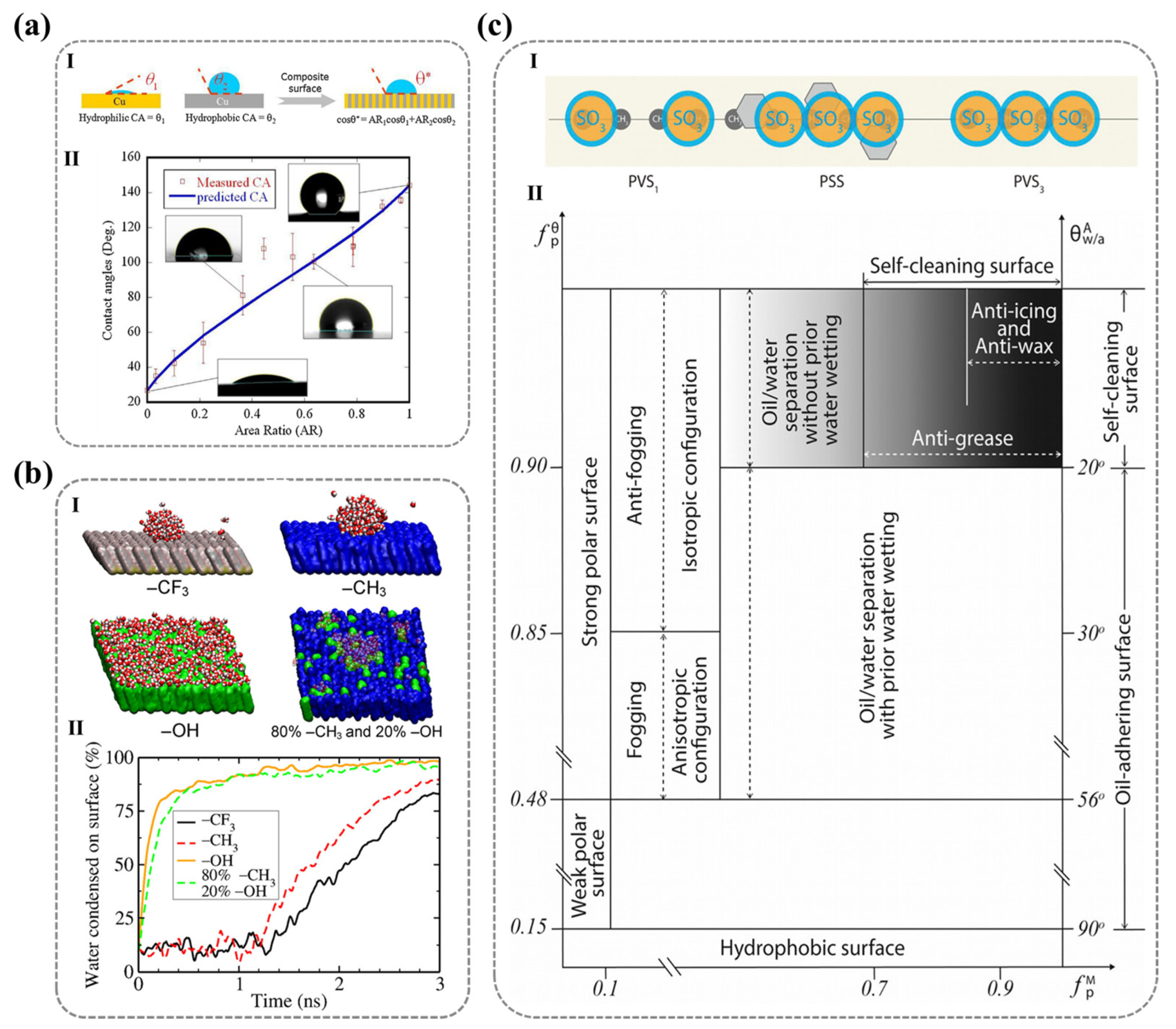
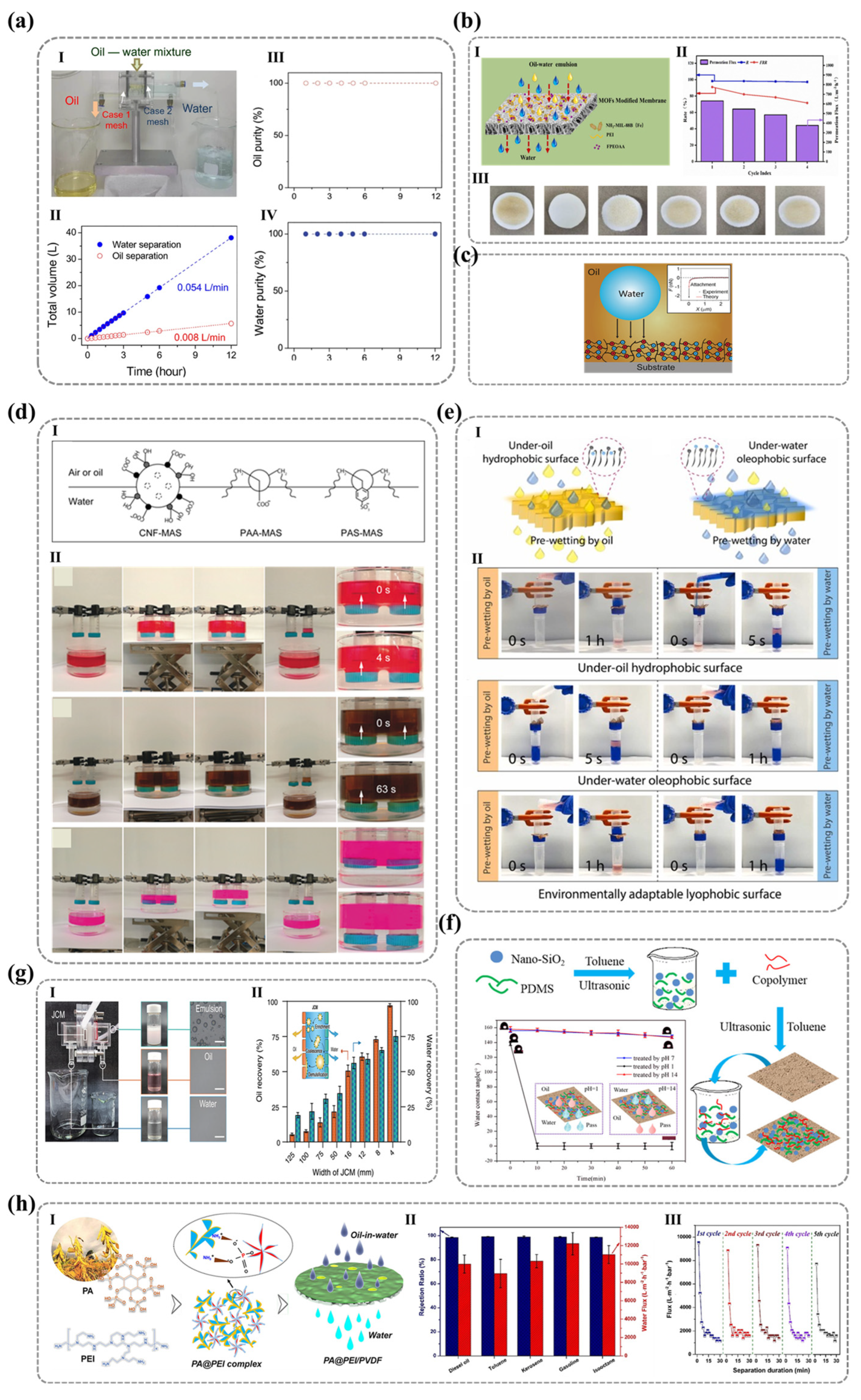

Disclaimer/Publisher’s Note: The statements, opinions and data contained in all publications are solely those of the individual author(s) and contributor(s) and not of MDPI and/or the editor(s). MDPI and/or the editor(s) disclaim responsibility for any injury to people or property resulting from any ideas, methods, instructions or products referred to in the content. |
© 2025 by the authors. Licensee MDPI, Basel, Switzerland. This article is an open access article distributed under the terms and conditions of the Creative Commons Attribution (CC BY) license (https://creativecommons.org/licenses/by/4.0/).
Share and Cite
Wang, H.; Cheng, C.; Wang, D. Holistic Molecular Design of Ionic Surfaces for Tailored Water Wettability and Technical Applications. Nanomaterials 2025, 15, 591. https://doi.org/10.3390/nano15080591
Wang H, Cheng C, Wang D. Holistic Molecular Design of Ionic Surfaces for Tailored Water Wettability and Technical Applications. Nanomaterials. 2025; 15(8):591. https://doi.org/10.3390/nano15080591
Chicago/Turabian StyleWang, Huiyun, Chongling Cheng, and Dayang Wang. 2025. "Holistic Molecular Design of Ionic Surfaces for Tailored Water Wettability and Technical Applications" Nanomaterials 15, no. 8: 591. https://doi.org/10.3390/nano15080591
APA StyleWang, H., Cheng, C., & Wang, D. (2025). Holistic Molecular Design of Ionic Surfaces for Tailored Water Wettability and Technical Applications. Nanomaterials, 15(8), 591. https://doi.org/10.3390/nano15080591







